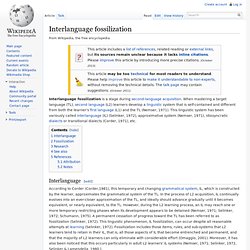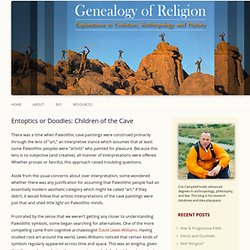

Interlanguage fossilization. Interlanguage fossilization is a stage during second-language acquisition.

When mastering a target language (TL), second language (L2) learners develop a linguistic system that is self-contained and different from both the learner’s first language (L1) and the TL (Nemser, 1971). This linguistic system has been variously called interlanguage (IL) (Selinker, 1972), approximative system (Nemser, 1971), idiosyncratic dialects or transitional dialects (Corder, 1971), etc. Understanding body language of mice: Scientists create new technology to read complex patterns of behavior.
It might not rival Newton's apple, which led to his formulating the law of gravity, but the collapse of a lighting scaffold played a key role in the discovery that mice, like humans, have body language.

Harvard Medical School scientists have developed new computational techniques that can make sense of the bodily movements of mice, organizing them into notions of syllables and grammar. Along the way they also proposed a solution to a longstanding problem in neuroscience--how to objectively study complex three-dimensional patterns of animal behavior without relying on subjective human observers. Their results appear in Neuron. "If you look into the brain and ask how any individual brain cell fires as an animal generates any given behavior, what you find is the brain is a very noisy place, and so understanding how brain activity leads to action is hard," said Sandeep Datta, HMS assistant professor of neurobiology and senior author of the paper.
Marine animals use new form of secret light communication. Researchers from the Queensland Brain Institute at The University of Queensland have uncovered a new form of secret light communication used by marine animals.

The findings may have applications in satellite remote sensing, biomedical imaging, cancer detection, and computer data storage. Dr Yakir Gagnon, Professor Justin Marshall and colleagues previously showed that mantis shrimp (Gonodactylaceus falcatus) can reflect and detect circular polarising light, an ability extremely rare in nature. Until now, no-one has known what they use it for. The new study shows the shrimp use circular polarisation as a means to covertly advertise their presence to aggressive competitors. "In birds, colour is what we're familiar with; in the ocean, reef fish display with colour. Linear polarised light is seen only in one plane, whereas circular polarised light travels in a spiral -- clockwise or anti-clockwise -- direction. Symboldictionary.net. Military Slang and/or Jargon Glossary - NCIS. DOD Dictionary of Military Terms : From this page you can browse the DOD (Dept of Defense) Dictionary of Military and Associated Terms.

Modern Military Terms : This is a glossary of modern military terms appended to the Combat magazine website. According to them, one reason the military has trouble coordinating joint operations is that the different services do not speak the same language. Although no longer in common use the semaphore flag code may be of interest to some given its similarity to Morse, see below: Sempahore is similar to Morse code in that each letter of a message is translated into another form to allow it to be more easily communicated. While Morse code is used to send messages electronically over a telegraph line, semaphore is used to visually communicate information over long distances. Morse Code and Phonetic Alphabet Page Below are listed Morse Code plus a few phonetic alphabets.
. - Scouting resources, how to read naval signals here from the UK Royal Navy. File:International Alphabet Flags, Phonetic Alphabet, Morse Code and Semaphore Alphabet 1956.png. Sign language alphabet. Everything You’ve Always Wanted to Know About Lipreading But Were Afraid to Ask. As a Lipreading Mom, I spend most of my days attempting to read the lips of three young children.

Difficult? It can be, but I’ve gotten lots of practice at it. Complex grammar of the genomic language. A new study from Sweden's Karolinska Institutet shows that the 'grammar' of the human genetic code is more complex than that of even the most intricately constructed spoken languages in the world.

The findings, published in the journal Nature, explain why the human genome is so difficult to decipher -- and contribute to the further understanding of how genetic differences affect the risk of developing diseases on an individual level. "The genome contains all the information needed to build and maintain an organism, but it also holds the details of an individual's risk of developing common diseases such as diabetes, heart disease and cancer," says study lead-author Arttu Jolma, doctoral student at the Department of Biosciences and Nutrition. "If we can improve our ability to read and understand the human genome, we will also be able to make better use of the rapidly accumulating genomic information on a large number of diseases for medical benefits.
" Entoptics or Doodles: Children of the Cave. There was a time when Paleolithic cave paintings were construed primarily through the lens of “art,” an interpretive stance which assumes that at least some Paleolithic peoples were “artists” who painted for pleasure.

Because this lens is so subjective (and creative), all manner of interpretations were offered. Whether prosaic or fanciful, this approach raised troubling questions. Aside from the usual concerns about over interpretation, some wondered whether there was any justification for assuming that Paleolithic people had an essentially modern aesthetic category which might be called “art.” If they didn’t, it would follow that artistic interpretations of the cave paintings were just that and shed little light on Paleolithic minds. Frustrated by the sense that we weren’t getting any closer to understanding Paleolithic symbols, some began searching for alternatives. How Learning a Human Language Is Like Learning a Computer Language - DZone Agile.
The Agile Zone is brought to you in partnership with Hewlett Packard Enterprise.

Discover how HP Agile enterprise solutions can help you achieve high predictability and quality in your development processes by knowing the status of your projects at any point in time. As programmers we get used to moving from one programming language to another, among language families this is relatively simple. When I refer to programming language families, for the purpose of this article I mean high level or low level languages. Between the different high level languages there are strong similarities both in structure of the statements and in vocabulary. The same applies to low level languages there are again strong similarities. Whistled language of the island of La Gomera (Canary Islands), the Silbo Gomero. 30 Dialects of the English language in the UK. Ancient India - Writing. Ancient India - Writing The assumption that the ancient Hindus could not read or write probably springs from the fact that no writing material was excavated on Indian soil.

That pictographs await excavation in India does not undermine the importance of literary evidence to the existence of writing skills of the Vedic folks. Also, it is suggested that no script was developed in Rig Vedic India since the verb "likha-to write" is not mentioned in the Vedas. Rig Veda is acclaimed as the oldest extant literature available to humans. It is definitely older than the Ramayan (at least 5500 B.C) and some internal evidence takes it as far as 23,000 B.C. Tamil. The Tamil script evolved from an ancient southern form of the Brahmi script, but was also influenced by the Grantha script.

Indus Script. 130520163859. Think of colors the same way: Assigning names to colors combines nature, nurture. Would a color by any other name be thought of in the same way, regardless of the language used to describe it? According to new research, the answer is yes. A new study examines how a culture of nomadic hunter-gatherers names colors, and shows that they group colors into categories that align with patterns of color grouping evident in 110 other world languages. This study population -- the Hadza people of Tanzania -- has relatively few commonly shared color words in its language. During the study, the most common response by Hadza participants to a request to name a color was "Don't know. " Language use is simpler than previously thought, study suggests. For more than 50 years, language scientists have assumed that sentence structure is fundamentally hierarchical, made up of small parts in turn made of smaller parts, like Russian nesting dolls.
A new Cornell study suggests language use is simpler than they had thought. Co-author Morten Christiansen, Cornell professor of psychology and co-director of the Cornell Cognitive Science Program, and his colleagues say that language is actually based on simpler sequential structures, like clusters of beads on a string. "What we're suggesting is that the language system deals with words by grouping them into little clumps that are then associated with meaning," he said. Sentences are made up of such word clumps, or "constructions," that are understood when arranged in a particular order. For example, the word sequence "bread and butter" might be represented as a construction, whereas the reverse sequence of words ("butter and bread") would likely not.
Testosterone changes brain structures in female-to-male transsexuals. Brain imaging shows that testosterone therapy given as part of sex reassignment changes the brain structures and the pathway associated with speech and verbal fluency. This result supports research that women in general may deal with speech and interaction differently than men. The sex hormone testosterone exerts a substantial influence on human behaviour and cognition. Previous studies have shown that testosterone has a particular influence on verbal fluency. 5 examples of how the languages we speak can affect the way we think. Keith Chen (TED Talk: Could your language affect your ability to save money?) Might be an economist, but he wants to talk about language. For instance, he points out, in Chinese, saying “this is my uncle” is not as straightforward as you might think.
In Chinese, you have no choice but to encode more information about said uncle. The language requires that you denote the side the uncle is on, whether he’s related by marriage or birth and, if it’s your father’s brother, whether he’s older or younger. Odors expressible in language, as long as you speak right language. It is widely believed that people are bad at naming odors.
This has led researchers to suggest smell representations are simply not accessible to the language centers of the brain. But is this really so? Psychologist Asifa Majid from Radboud University Nijmegen and linguist Niclas Burenhult from Lund University Sweden find new evidence for smell language in the Malay Peninsula. The research appeared online in Cognition, 23 December 2013. English speakers struggle to name odors. Weak evidence for word-order universals: Language not as 'innate' as thought? Chinese-English bilinguals are 'automatic' translators. International Phonetic Alphabet. Phonetic Alphabet. Types of Writing Systems. Writing systems can be conveniently classified into broad "types" depending on the way they represent their underlying languages. Logographic A system of this kind uses a tremendous number of signs, each to represent a morpheme. Timeline. Akkadian. While the cuneiform writing system was created and used at first only by the Sumerian, it did not take long before neighboring groups adopted it for their own use.
By about 2500 BCE, the Akkadian, a Semitic-speaking people that dwelled north of the Sumerians, starting using cuneiform to write their own language. Sumerian. South Asian Writing Systems Comparison. Mesoamerican Writing Systems. Extending from the deserts of northern Mexico to the dry tropical forests of northwestern Costa Rica, Mesoamerica is a geographically and ethnically diverse area that included thousands of cultures united by similarities in religion, art, language, and sociopolitical organization. Brahmi.